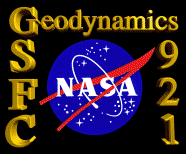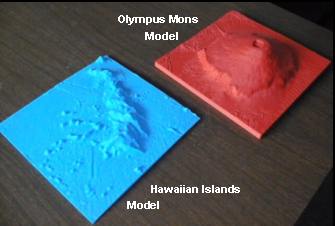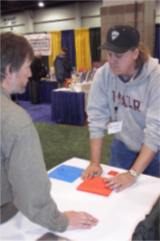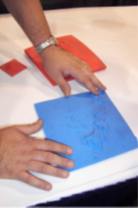Geodynamics Science Highlight

SCIENCE HIGHLIGHT
Geodynamics Branch, Code 921
December 2002
921 Teams with 691 on Successful Educational DDF Proposal
Sakimoto, Stockman, Roark and Frey Involved in 3-Dimensional Model
Making for Classroom Teacher Kits Demonstrating Comparative Planetary Surface Features
John Keller of Code 691 makes plastic models of spacecraft parts - and planetary
surface features. The same plastic extrusion device obtained to support mission
development work can be used to make 3-dimensional models of volcanoes, river
valleys, impact craters and other features - provided a really good topography data
set exists. MOLA (Mars Orbiting Laser Altimeter) has provided such data for Mars
and comparable data exists for many parts of the Earth. So it is possible to make
high accuracy topographic maps of surface features of interest. But flat views,
even in perspective, do not fully convey the volumetric aspects of such objects.
This is where models, like those of volcanoes at the right, can be useful.

|
Models of the Hawaiian Island chain
(Earth) and the single volcano Olympus Mons
(Mars) at the same horizontal scale and same
vertical exaggeration). |
"Exploring Planetary Topography in the Classroom Using 3-Dimensional Models"
is the title of a Director’s Discretionary Fund proposal recently won by Keller and
four 921 co-investigators. Susan Sakimoto, Stephanie Stockman, Jim Roark and
Herb Frey provided expertise in Earth and Mars geology, use of MOLA and Earth-
based topographic data, and educational outreach using planetary analogs. Keller
generated a number of example models for display at both the DDF presentation
and at the Fall Geological Society of America (GSA) meeting. At the GSA a visually
impaired undergraduate took advantage of the models (right). The DDF proposal is
to develop teacher kits and lesson plans around comparative features on the two
planets. These will be tested out in classrooms by teachers in Sakimoto’s course
“Teaching the Solar System” in the Spring at Johns Hopkins University.

|

|
Wade Bailey uses touch to explore models he cannot see. |
Contact: Herb Frey, GSFC, Code 921 (Herbert.V.Frey@nasa.gov)

 Back to Geodynamics Science Highlights
Back to Geodynamics Science Highlights
Responsible NASA official: Dr. Herbert Frey
This page maintained by Jim Roark (SSAI)
Last modified on Jan 3, 2003





![]()
![]() Back to Geodynamics Science Highlights
Back to Geodynamics Science Highlights